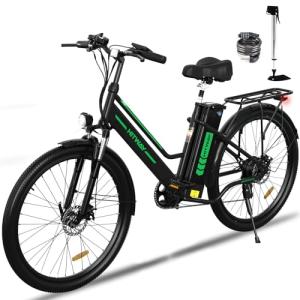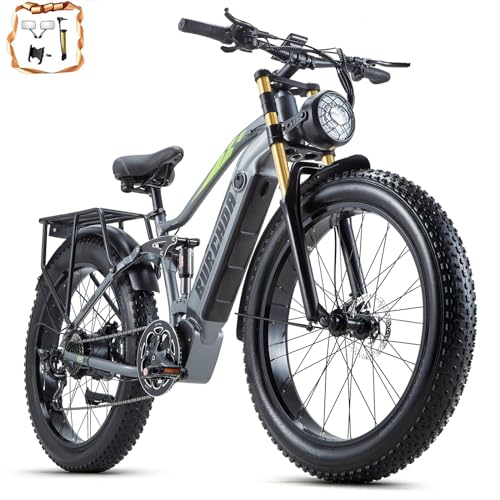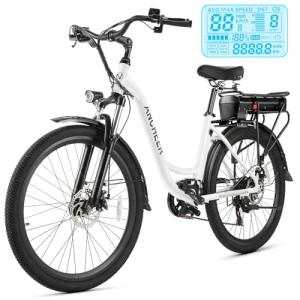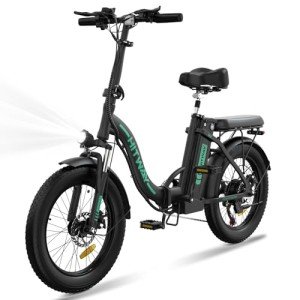Introduction
Importance of selecting the right bicycle
Choosing the right bicycle is not merely a matter of selecting a mode of transportation; it's about finding a vehicle that aligns with your lifestyle, preferences, and aspirations. Whether you're a seasoned cyclist or just starting out, your bike becomes an extension of yourself, facilitating your journeys, adventures, and personal growth. An ill-suited bike can lead to discomfort, dissatisfaction, and potentially deter you from cycling altogether. Conversely, a well-chosen bike enhances your experience, promotes physical well-being, and fosters a deeper connection with the world around you.
Brief overview of factors to consider
Selecting the perfect bicycle involves a myriad of factors, each playing a crucial role in the decision-making process. From understanding your riding style and preferences to considering frame materials, fit, and budget constraints, every aspect contributes to finding the ideal match. By addressing these elements systematically, you empower yourself to make an informed decision that reflects your unique needs and desires, ensuring a harmonious relationship with your bike for years to come.
Preview of sections
This comprehensive guide will walk you through the intricacies of choosing the right bicycle for you. We'll explore the nuances of different riding styles, delve into the intricacies of bicycle types and frame materials, and discuss the importance of proper bike fit and budget considerations. Additionally, we'll examine the significance of test rides, offer tips for researching and comparing brands and models, and provide insights into selecting accessories and maintaining your new bike. By the end of this journey, you'll be equipped with the knowledge and confidence to embark on your cycling adventures with the perfect companion by your side.
Determine Your Riding Style
Different types of riding
Cycling encompasses a diverse array of activities, each catering to different interests, terrains, and levels of intensity. From leisurely cruises through urban landscapes to adrenaline-fueled descents down rugged mountain trails, there's a cycling discipline for every enthusiast. Understanding the various types of riding allows you to identify your niche and tailor your bike selection accordingly, ensuring that your chosen steed is perfectly suited to your preferred mode of exploration and expression.
Identify your primary riding needs and preferences
Beyond the broad categories of cycling disciplines lie individual preferences, goals, and riding habits that shape your experience on two wheels. Consider the environments you'll frequent, the distances you'll cover, and the pace at which you'll travel. Are you drawn to the camaraderie of group rides, the solitude of solo adventures, or the thrill of competitive racing? By honing in on your specific needs and desires, you can pinpoint the attributes that matter most in your quest for the perfect bike.
Understand Bicycle Types
Road bikes, mountain bikes, hybrid bikes, etc.
Each type of bicycle is purpose-built to excel in particular conditions, offering distinct advantages and trade-offs that cater to diverse riding styles and environments. Road bikes feature lightweight frames, narrow tires, and aerodynamic designs optimized for speed and efficiency on smooth pavement. Mountain bikes boast rugged construction, wide tires, and suspension systems capable of conquering rough terrain and technical trails. Hybrid bikes blend elements of both, providing versatility and comfort for a wide range of riding scenarios.
Features and benefits of each type
The unique characteristics of each bicycle type contribute to its performance and suitability for specific riding conditions. Road bikes prioritize aerodynamics and power transfer, making them ideal for long-distance rides and spirited sprints. Mountain bikes prioritize traction and control, enabling riders to tackle challenging off-road terrain with confidence and composure. Hybrid bikes offer a balanced blend of comfort and capability, allowing riders to explore a variety of surfaces and environments without sacrificing performance or efficiency.
Matching bike type with riding style
Selecting the right bicycle type hinges on aligning its attributes with your intended riding style and preferences. Consider the terrain you'll encounter, the distances you'll travel, and the level of comfort and control you desire. Whether you're chasing speed on smooth roads, seeking adventure on rugged trails, or navigating urban streets with ease, choosing a bike type that complements your lifestyle ensures a fulfilling and enjoyable riding experience.
Consider Frame Material and Geometry
Common frame materials
The material composition of a bicycle frame influences its weight, stiffness, durability, and ride quality, shaping the overall feel and performance of the bike. Steel frames offer a classic aesthetic and a smooth, supple ride, absorbing road vibrations and providing a lively feel. Aluminum frames are lightweight and affordable, offering excellent stiffness and responsiveness for efficient power transfer. Carbon fiber frames deliver unmatched strength-to-weight ratios and vibration damping properties, making them the material of choice for high-performance applications. Titanium frames combine lightweight construction with exceptional durability and corrosion resistance, appealing to discerning riders seeking a lifetime investment.
Impact of frame geometry on comfort and performance
Frame geometry plays a pivotal role in determining a bike's handling characteristics, stability, and rider positioning. Factors such as stack height, reach, head tube angle, and chainstay length influence how a bike handles different terrain and how comfortable it feels over long distances. A more aggressive geometry prioritizes aerodynamics and power transfer, ideal for racing and spirited riding. Conversely, a relaxed geometry emphasizes comfort and stability, enhancing endurance and reducing fatigue on extended outings. By understanding how frame geometry affects ride quality, you can select a bike that aligns with your performance goals and riding preferences.
Choosing the right frame material and geometry for your needs
When evaluating frame materials and geometries, consider your riding style, performance objectives, and personal preferences. If comfort and durability are paramount, a steel or titanium frame with relaxed geometry may offer the ideal blend of ride quality and longevity. For riders seeking maximum performance and responsiveness, a carbon fiber or aluminum frame with aggressive geometry may provide the edge needed to push limits and chase personal bests. By weighing the pros and cons of each option, you can make an informed decision that optimizes your riding experience and maximizes enjoyment on the road or trail.
Assess Bike Fit
Importance of proper bike fit for comfort and performance
Achieving a proper bike fit is essential for maximizing comfort, efficiency, and performance while riding. A bike that fits well allows you to maintain an optimal riding position, minimize fatigue, and prevent discomfort or injury over time. Whether you're embarking on epic adventures or leisurely cruises, investing in a professional bike fitting ensures that your bike becomes an extension of your body, enhancing your connection with the ride and facilitating your cycling aspirations.
Factors influencing bike fit
Several key factors contribute to bike fit, including frame size, saddle height, saddle position, handlebar reach, and stem length. Fine-tuning these measurements ensures that your bike accommodates your unique biomechanics and riding style, promoting efficiency and minimizing strain on your body. By understanding how each factor affects your comfort and performance, you can make adjustments that optimize your riding experience and alleviate potential sources of discomfort or inefficiency.
Seeking professional assistance for bike fitting
While basic fit adjustments can be made independently, seeking professional assistance from a certified bike fitter offers unparalleled precision and expertise. A skilled fitter assesses your riding position, analyzes your biomechanics, and recommends adjustments tailored to your individual needs and goals. Through comprehensive evaluation and meticulous attention to detail, a professional bike fitting enhances your comfort, confidence, and enjoyment on the bike, unlocking your full potential as a cyclist.
Budget Considerations
Setting a realistic budget
Establishing a realistic budget is the cornerstone of a successful bike purchase, ensuring that you make informed decisions within your financial means. Consider your overall investment in cycling, including the cost of the bike, accessories, maintenance, and ongoing expenses. By setting clear financial parameters, you can shop with confidence, knowing that you're making choices that align with your priorities and resources.
Understanding price ranges for different bike types
Bicycles span a wide range of price points, from entry-level options to premium models equipped with cutting-edge technology and components. Understanding the typical price ranges for different bike types allows you to narrow your search and focus on options that offer the best value within your budget. While higher-priced bikes often feature lighter weight, improved performance, and enhanced durability, there are plenty of affordable options that deliver exceptional quality and ride characteristics for budget-conscious riders.
Balancing budget constraints with desired features and quality
When navigating budget constraints, it's essential to strike a balance between desired features, quality, and affordability. Evaluate the features and components that matter most to you, such as frame material, drivetrain quality, and wheelset construction, and prioritize investments that offer the greatest impact on your riding experience. By identifying areas where you're willing to compromise and areas where quality is non-negotiable, you can allocate your budget effectively and maximize the value of your investment in cycling.
Test Ride Multiple Bikes
Importance of test rides in decision-making
Test riding multiple bikes is a crucial step in the bike-buying process, offering firsthand experience of how different models perform and feel on the road or trail. While specifications and reviews provide valuable insights, nothing compares to the tactile sensation of riding a bike and gauging its suitability for your needs. Test rides allow you to assess factors such as comfort, handling, responsiveness, and fit, empowering you to make an informed decision based on your own riding experience.
Evaluating bike handling, comfort, and fit during test rides
During test rides, pay close attention to how each bike handles various terrain, from smooth pavement to rough trails. Notice how the bike responds to your inputs, accelerates, and corners, and whether it instills confidence and control. Assess the comfort of the saddle, the position of the handlebars, and the overall fit of the bike, making note of any areas of discomfort or strain. By evaluating these factors systematically, you can determine which bike best aligns with your riding style, preferences, and body geometry.
Testing bikes under conditions similar to your typical riding environment
Whenever possible, test ride bikes under conditions that mirror your typical riding environment, whether that's urban streets, winding country roads, or rugged mountain trails. By experiencing the bike in its intended habitat, you gain a more accurate sense of its performance and suitability for your needs. Pay attention to how the bike handles different surfaces, inclines, and obstacles, and consider how well it adapts to the challenges you'll encounter in your day-to-day cycling adventures. Testing bikes in real-world conditions provides invaluable insights that can inform your final decision and ensure a harmonious match between rider and machine.
Research and Compare Brands and Models
Reading reviews and seeking recommendations
Gathering insights from reviews and recommendations from fellow cyclists, industry experts, and reputable sources can provide valuable guidance in your bike-buying journey. Online forums, cycling publications, and social media platforms offer a wealth of firsthand experiences and perspectives that can help you narrow down your options and identify bikes that align with your needs and preferences. Pay attention to common themes, pros and cons, and specific features that resonate with your riding style and aspirations.
Comparing specifications, features, and prices of different models
Comparing the specifications, features, and prices of different bike models allows you to make informed comparisons and identify the best value for your investment. Create a spreadsheet or list to track key metrics such as frame material, drivetrain components, wheelset specifications, and price points across various brands and models. Consider factors such as weight, performance, durability, and warranty coverage when evaluating different options, and prioritize features that align with your riding priorities and goals.
Considering factors like warranty, customer service, and resale value
Beyond the bike itself, consider additional factors such as warranty coverage, customer service reputation, and resale value when evaluating different brands and models. A generous warranty policy and responsive customer support can provide added peace of mind and support in the event of issues or concerns with your bike. Likewise, brands with a strong resale value and loyal customer base may offer greater long-term value and investment potential. By considering these factors holistically, you can make a more informed decision that reflects your priorities and preferences as a cyclist.
Accessories and Additional Considerations
Necessary accessories
Certain accessories are essential for safe and enjoyable cycling, enhancing both your comfort and safety on the road or trail. Among these, a properly fitted helmet is paramount to protect against head injuries in the event of a fall or collision. Additionally, investing in high-quality lights ensures visibility in low-light conditions, while a sturdy lock provides security when parking your bike. Basic maintenance tools, such as tire levers, a multitool, and a pump, enable you to perform routine repairs and adjustments while out on a ride, ensuring you stay prepared for any eventuality.
Optional accessories based on riding style and preferences
In addition to essential accessories, consider optional add-ons that enhance your riding experience and cater to your specific needs and preferences. For instance, a bike computer or GPS device provides valuable metrics such as speed, distance, and navigation, allowing you to track your progress and explore new routes with confidence. A water bottle cage ensures hydration during longer rides, while fenders and a rack offer convenience and versatility for commuting or touring. Saddlebags or panniers provide storage for essentials such as spare tubes, snacks, and tools, enabling you to carry everything you need for extended adventures without sacrificing comfort or performance.
Factor in additional costs for accessories and customization
When budgeting for your new bike, don't overlook the cost of accessories and customization, as these can significantly impact the overall expense of your cycling setup. While some accessories may be included with the purchase of the bike or available as optional add-ons, others may require separate purchases and installation. Factor in the cost of essential accessories, such as a helmet and lock, as well as any optional add-ons or customization, such as upgraded components or personalized fit adjustments. By accounting for these additional costs upfront, you can ensure that your budget aligns with your desired bike setup and riding experience.
Final Decision and Maintenance
Making the final decision based on research, test rides, and budget
After conducting thorough research, test riding multiple bikes, and considering your budget constraints, it's time to make the final decision and purchase your new bicycle. Reflect on your experiences during test rides, weigh the pros and cons of different models, and ensure that your chosen bike aligns with your riding style, preferences, and aspirations. Consider factors such as frame material, geometry, components, and overall value for money. Trust your instincts and choose the bike that resonates with you the most, knowing that it will be your faithful companion on countless cycling adventures to come.
Importance of regular bike maintenance for longevity and performance
Once you've acquired your new bicycle, prioritize regular maintenance to ensure its longevity and optimal performance. Establish a maintenance schedule that includes tasks such as cleaning, lubricating, and inspecting your bike after each ride or at regular intervals. Pay attention to components such as the drivetrain, brakes, and tires, and address any issues promptly to prevent further damage or safety hazards. Periodically check for signs of wear or damage, such as worn brake pads or loose bolts, and replace or tighten as necessary. By investing time and effort into bike maintenance, you'll extend the lifespan of your bicycle and enjoy reliable performance on every ride.
Celebrating your new bike and enjoying the ride!
Finally, take a moment to celebrate your new bicycle and the exciting adventures that lie ahead. Whether you're commuting to work, exploring scenic trails, or embarking on epic cycling tours, savor the freedom and joy that cycling brings. Embrace the journey, challenge yourself to new heights, and relish the sense of accomplishment with each pedal stroke. Share your passion for cycling with friends, family, and fellow riders, and inspire others to join you on the road to discovery. With your new bike as your trusty steed, the possibilities are endless, so go forth and enjoy the ride!
Conclusion Choosing the Right Bicycle
Reflecting on the journey
Choosing the right bicycle is more than just a transaction; it's a journey of self-discovery, exploration, and personal growth. Throughout this process, you've delved into the intricacies of cycling, explored different riding styles, and evaluated various factors to find the perfect match for your needs and preferences. Along the way, you've experienced the thrill of test rides, the satisfaction of research and comparison, and the anticipation of finally selecting your new bike. As you reflect on this journey, take pride in the knowledge and confidence you've gained, knowing that you've made an informed decision that aligns with your passion for cycling.
Embracing the cycling community
Cycling is more than just a solo endeavor; it's a vibrant and inclusive community that welcomes riders of all backgrounds, abilities, and interests. As you embark on your cycling adventures with your new bike, embrace the camaraderie and support of fellow cyclists, whether on group rides, social events, or online forums. Share your experiences, exchange tips and advice, and celebrate the joys of cycling together. By fostering connections within the cycling community, you'll enrich your riding experience and forge lasting friendships that enhance your journey on two wheels.
Seizing the endless possibilities
With your new bike as your faithful companion, the possibilities for exploration and adventure are limitless. Whether you're embarking on epic bikepacking trips, conquering challenging mountain trails, or simply cruising through your neighborhood, seize every opportunity to experience the joy and freedom of cycling. Embrace the beauty of nature, revel in the sense of accomplishment, and cherish the moments of tranquility and solitude that cycling affords. With each pedal stroke, you'll discover new landscapes, overcome obstacles, and uncover the boundless potential that lies within you.
Committing to lifelong enjoyment
As you embark on this new chapter of your cycling journey, commit to lifelong enjoyment and fulfillment on two wheels. Embrace the challenges, celebrate the victories, and embrace the process of continuous improvement and growth as a cyclist. Whether you're pushing your limits, exploring new horizons, or simply enjoying the ride, remember that cycling is not just a hobby—it's a lifestyle that enriches your mind, body, and soul. So saddle up, pedal forth, and let the journey begin!







